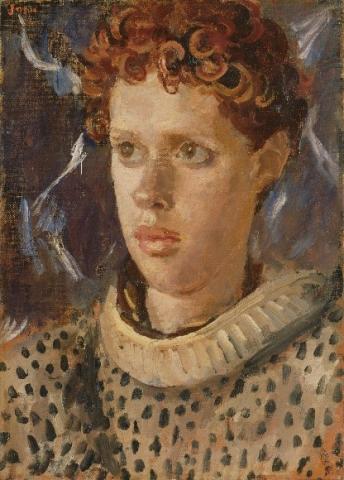
National Portrait Gallery Acquires Portrait of Poet Dylan Thomas by Augustus John
Painting linking two Welsh icons will travel to Swansea in 2019 as part of Gallery’s Coming Home project

The National Portrait Gallery has acquired a portrait of Dylan Thomas by his close friend Augustus John, it was announced today, Thursday 16 August 2018. The portrait, which links two of the most significant cultural figures in twentieth century Britain, has been purchased with support from the National Heritage Memorial Fund, Art Fund and The Thompson Family Foundation.
The work, one of two portraits of Dylan Thomas by artist and fellow Welshman Augustus John, is a particularly striking portrayal of a young Thomas, painted in the 1930s when the poet was just twenty-three and at the height of his creativity. The painting was previously on long-term loan to the National Portrait Gallery, London where it has been on permanent display for twenty years.
The newly acquired portrait will now go on loan to the Glynn Vivian Art Gallery in Thomas’ hometown of Swansea in 2019 as part of the Gallery’s Coming Home project - a new initiative, which will see fifty portraits from the national Collection travel to places across the UK they are most closely associated with.
Dylan Thomas met the painter Augustus John at the Fitzroy Tavern in London's Charlotte Street in the early 1930s. Thomas had become a distinctive figure in bohemian circles in Soho and Fitzrovia and the two furthered their friendship during many evenings there and in the nearby Marquis of Granby on Rathbone Street. In the spring of 1936 the painter introduced Thomas to his future wife, Caitlin Macnamara, whom he married the following year.
The portrait is a product of the close acquaintance between the poet and artist. Thomas sat for John twice shortly after his marriage to Caitlin Macnamara, during visits to Hampshire to stay with Caitlin’s mother, who lived close to John’s studio. Of his exuberant sitter the artist wrote ‘we frequently met ... I got him to sit for me twice, the second portrait being the more successful: provided with a bottle of beer he sat very patiently.’ The other portrait (whether this is the first or second of the two is not known) is now in the collection of the National Museum Wales.
Dr Nicholas Cullinan, Director, National Portrait Gallery, London said: ‘We are delighted to have acquired one of the finest known portraits of Dylan Thomas, representing the Welsh poet at the peak of his literary career. We are extremely grateful to the National Heritage Memorial Fund, Art Fund and The Thompson Family Foundation for their generous support. I am especially pleased that the portrait will go on loan next year to the Glynn Vivian Art Gallery in Thomas’ hometown of Swansea as part of our Coming Home project, allowing this important portrait, which links two of Wales’ greatest cultural icons, to travel to their home nation.’
Jenni Spencer-Davies, Curator, Glynn Vivian Art Gallery, Swansea said: ‘We are delighted to be able to present this remarkable early portrait of Dylan Thomas, which was painted by Augustus John when he first introduced Dylan to Caitlin MacNamara, whose portrait he also painted in this period, which is in our collection at the Glynn Vivian Art Gallery. So Coming Home has a special resonance not only for the poet returning to his home town, Swansea, but he will also be joining the Portrait of Caitlin who became his wife at this time in 1937. We are incredibly grateful to the National Portrait Gallery for bringing Dylan and Caitlin back together, captured at this special moment in time by Augustus John.’
Stephen Deuchar, Director, Art Fund, said: ‘Augustus John’s portraits capture likeness and character with great economy, and this warm portrayal of the poet Dylan Thomas shows the painter at his most assured. Art Fund is proud to support the National Portrait Gallery in acquiring this fine work: it’s a wonderful addition to the gallery’s collection as well as to their Coming Home initiative, which will allow visitors from Swansea and beyond to connect with a famous sitter at first hand.’
The Portrait was purchased for £214,750 with a contribution of £94,800 from National Heritage Memorial Fund, £70,000 from Art Fund and £49,950 from The Thompson Family Foundation. Christie’s helped broker the Private Treaty Sale to the National Portrait Gallery, led by Christie’s Heritage and Taxation Advisory Service in conjunction with the Modern British Department.
For further press information please contact: Laura McKechan, Senior Communications Manager, National Portrait Gallery, Tel. 020 7321 6620 (not for publication)/Email lmckechan@npg.org.uk
Notes to editors
Augustus John (1878 – 1961) is widely regarded as one of the most important British artists of the early twentieth century, celebrated for his keenly observed drawings and expressive portraits. Born in Tenby, Wales, he was the brother of fellow artist Gwen John. He studied at the Slade School of Art, London (1894-98), where he was a brilliant student and quickly gained a reputation as an outstanding draughtsman. A hugely charismatic figure, John cultivated a strong bohemian image and became a leading figure of the avant-garde in the Edwardian period. In 1900 he began exhibiting at the New English Art Club, becoming a member in 1903. He also became involved in the Camden Town Group but remained largely independent from artistic trends and movements. By the
1920s he was one of the leading portraitists of his day, excelling in penetrating paintings of distinguished contemporaries including Dylan Thomas, Jacob Epstein, George Bernard Shaw and T.E. Lawrence. He was elected to the Royal Academy in 1928. Throughout his life John travelled widely in Europe and lived in Dorset, London and later in Hampshire where he died in 1961.
Dylan Thomas (1914 – 1953) was one of the most significant literary figures of his generation. By the time of his premature death aged thirty-nine he had achieved both popular acclaim and critical recognition. Born in Swansea, South Wales, Thomas left school at sixteen and began writing as a journalist for a local newspaper before moving to London. By the age of nineteen he had written more than two hundred poems. Half of the ninety poems that were published in his lifetime were written at this time. These include ‘And Death shall have no Dominion’ and ‘The Force that through the Green Fuse Drives the Flower’. Thomas’s first published collections, 'Eighteen Poems' (1934) and 'Twenty-Five Poems' (1936), established him in literary circles and are the foundation of his reputation. He married Caitlin Macnamara in 1937 and their life together was stormy, poverty-stricken and fuelled by alcohol. Further poems and short stories were published as 'The Map of Love' (1939),'Portrait of the Artist as a Young Dog' (1940) and 'Deaths and Entrances' (1946), many of which evoke his early life in Wales. During the Second World War Thomas wrote scripts for the BBC, and his subsequent work as a broadcaster brought him wider public popular attention. He toured America in 1950, 1952 and 1953, and his readings there cemented his fame. His 1954 radio play
'Under Milk Wood' was completed shortly before his death, his health undermined by alcoholism. The play was first broadcast by the BBC in January 1954.
Coming Home
Coming Home is a major new project which will see the National Portrait Gallery loan portraits of iconic individuals to places across the UK they are most closely associated with. The initiative will enable fifty portraits from the national Collection to travel to towns and cities across the country from 2019 onwards and has been made possible by the Department for Digital, Culture, Media and Sport, and generous contributions from The Thompson Family Charitable Trust and funds raised at the Gallery’s Portrait Gala in 2017.
National Portrait Gallery
The National Portrait Gallery was founded in 1856 to encourage through portraiture the appreciation and understanding of the people who have made and are making British history and culture. Today it promotes engagement with portraiture in all media to a wide-ranging public by conserving, growing and sharing the world’s largest collection of portraits. The Gallery, just off Trafalgar Square, holds the most extensive collection of portraits in the world. With over 1000 portraits on display, across three floors, from Elizabeth I to David Beckham, the Gallery has something for everyone. Artists featured range from Holbein to Hockney, and the Collection includes work across all media, from painting and sculpture to photography and video. As well as the permanent displays, the Gallery has a diverse and ever-changing programme of exhibitions and events that promote an understanding and appreciation of portraiture in all forms. www.npg.org.uk.
Art Fund
Art Fund is the national fundraising charity for art. In the past five years alone Art Fund has given £34 million to help museums and galleries acquire works of art for their collections. It also helps museums share their collections with wider audiences by supporting a range of tours and exhibitions, and makes additional grants to support the training and professional development of curators. Art Fund is independently funded, with the core of its income provided by 139,000 members who receive the National Art Pass and enjoy free entry to over 240 museums, galleries and historic places across the UK, as well as 50% off entry to major exhibitions and subscription to Art Quarterly magazine. In addition to grant-giving, Art Fund’s support for museums includes Art Fund Museum of the Year (won by Tate St Ives in 2018) and a range of digital platforms.
Find out more about Art Fund and the National Art Pass at www.artfund.org

